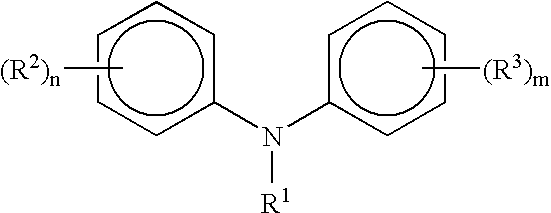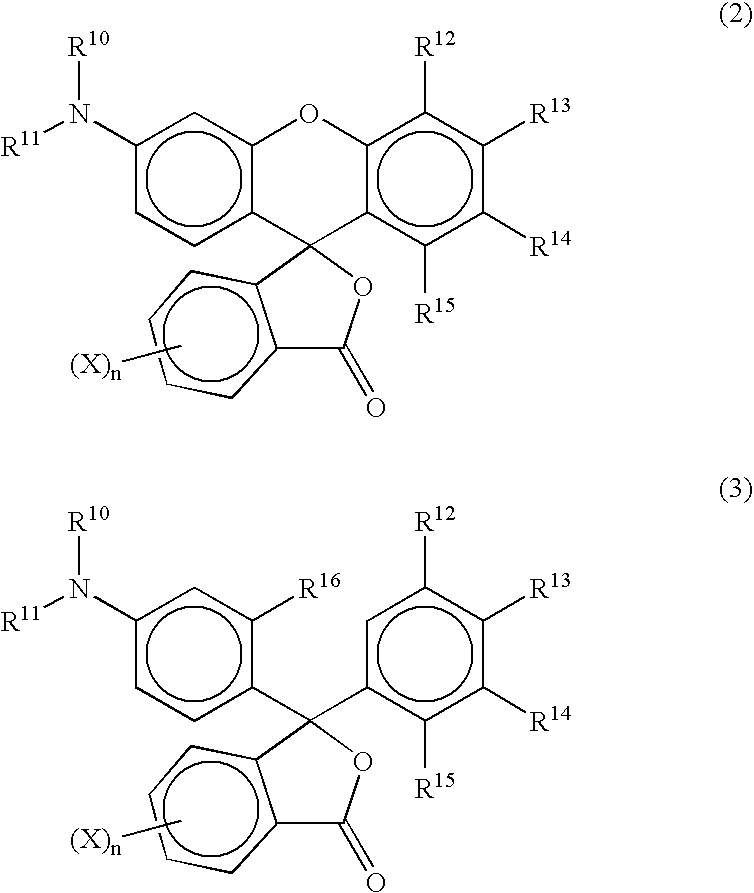Process for manufacturing diphenylamines
a technology of diphenylamine and manufacturing process, which is applied in the field of new process for manufacturing diphenylamine, can solve the problems of difficult to isolate products, unattractive methods, and methods that are not amenable to commercial scale manufacture of diphenylamines
- Summary
- Abstract
- Description
- Claims
- Application Information
AI Technical Summary
Problems solved by technology
Method used
Image
Examples
example 1
Preparation of 4-Methoxy-2-methyldiphenylamine
[0039]
[0040] 4-Bromo-3-methylanisole (10.0 g, 0.05 mole) and aniline (4.9 g, 0.05 mole) in toluene (50 ml) were placed in a 250 ml, three-necked, round-bottom flask equipped with a mechanical stirrer and a reflux condenser. Aqueous potassium hydroxide (5.0 g / 10 ml of water) and cetyltrimethylammonium bromide (100 mg, 0.00027 mole) were added to the contents of the flask with stirring. After warming the flask to 90° C., bis[tri(t-butyl)phosphine]palladium [0] (250 mg, 0.0005 mole) was added and the progress of the reaction was monitored by gas chromatography (OV-1 column, 100° C. for 2 minutes, 25° C. / minute to 300° C.). After 15 minutes, GC analysis of the reaction mixture showed that the reaction was complete. The reaction mixture was cooled to room temperature; diluted with water and brine stirred for few minutes; the toluene layer was separated and the aqueous layer was extracted twice with toluene. The toluene extracts were combined...
example 2
Preparation of 4-Methoxy-2,2′,4′-trimethyldiphenylamine
[0041]
[0042] 4-Bromo-3-methylanisole (10.0 g, 0.05 mole) and 2,4-dimethylaniline (6.1 g, 0.05 mole) in toluene (50 ml) were placed in a 250 ml, three-necked, round-bottom flask equipped with a mechanical stirrer and a reflux condenser. Aqueous potassium hydroxide (5.0 g / 10 ml of water) and cetyltrimethylammonium bromide (100 mg, 0.00027 mole) were added to the contents of the flask with stirring. After warming the flask to 90° C., bis[tri(t-butyl)phosphine]palladium [0] (250 mg, 0.0005 mole) was added and the progress of the reaction was monitored by gas chromatography (OV-1 column, 100° C. for 2 minutes, 25° C. / minute to 300° C.). After 15 minutes, GC analysis of the reaction mixture showed that the reaction was complete. The reaction mixture was cooled to room temperature; diluted with water and brine stirred for few minutes and the toluene layer was separated and the aqueous layer was extracted twice with toluene. The toluen...
example 3
Preparation of N-Ethyl-3-methoxy-4′-methyldiphenylamine using 3-Bromoanisole
[0043]
[0044] 3-Bromoanisole (9.4 g, 0.05 mole) and N-methyl-4-toluidine (6.8 g, 0.05 mole) in toluene (50 ml) were placed in a 250 ml, three-necked, round-bottom flask equipped with a mechanical stirrer and a reflux condenser. Aqueous potassium hydroxide (5.0 g / 10 ml of water) and cetyltrimethylammonium bromide (100 mg, 0.00027 mole) were added to the contents of the flask with stirring. After warming the flask to 90° C., bis[tri(t-butyl)phosphine]palladium [0] (250 mg, 0.0005 mole) was added and the progress of the reaction was monitored by gas chromatography (OV-1 column, 100° C. for 2 minutes, 25° C. / minute to 300° C.). After 30 minutes, GC analysis of the reaction mixture showed that the reaction was complete. The reaction mixture was cooled to room temperature; diluted with water and brine stirred for few minutes and the toluene layer was separated and the aqueous layer was extracted twice with toluene...
PUM
| Property | Measurement | Unit |
|---|---|---|
| temperature | aaaaa | aaaaa |
| temperature | aaaaa | aaaaa |
| temperature | aaaaa | aaaaa |
Abstract
Description
Claims
Application Information
 Login to View More
Login to View More - R&D
- Intellectual Property
- Life Sciences
- Materials
- Tech Scout
- Unparalleled Data Quality
- Higher Quality Content
- 60% Fewer Hallucinations
Browse by: Latest US Patents, China's latest patents, Technical Efficacy Thesaurus, Application Domain, Technology Topic, Popular Technical Reports.
© 2025 PatSnap. All rights reserved.Legal|Privacy policy|Modern Slavery Act Transparency Statement|Sitemap|About US| Contact US: help@patsnap.com



